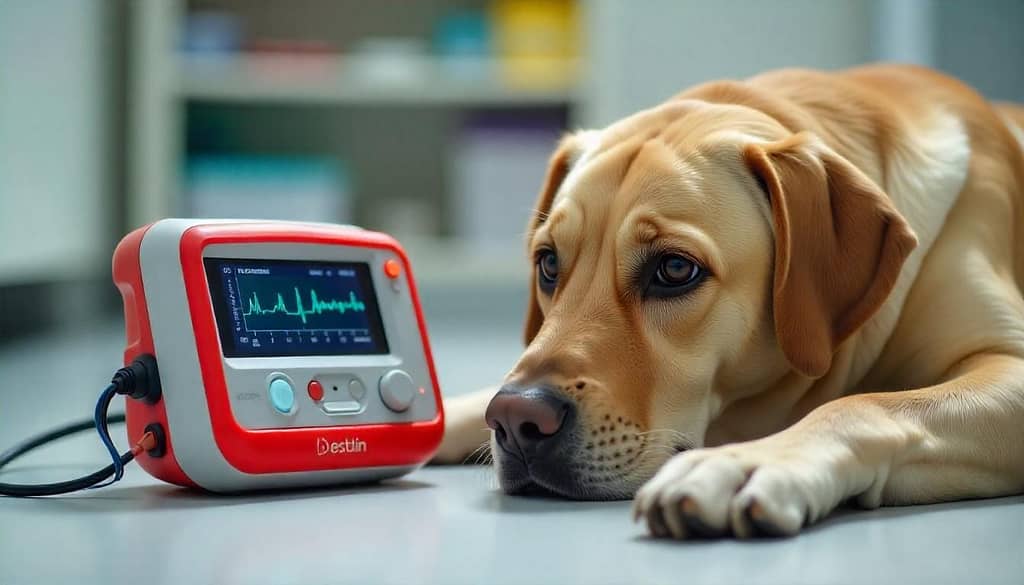Your dog is not just a pet- they are family. Yet, many owners feel helpless during crises like dog cardiac arrest, where seconds determine survival. Unlike humans, dogs canot dial 911, making your knowledge of canine CPR and AED use their lifeline. Cardiac emergencies in dogs are more common than you’d think: trauma, choking, or underlying heart disease can trigger sudden collapse. Acting swiftly with CPR doubles survival chances , while AEDs (automated external defibrillators) can restore normal heart rhythms.
This guide isn’t just a checklist. We’ll walk you through recognizing early warning signs, mastering vet- approved CPR techniques, and even using AEDs tailored for dogs- skills most pet owners overlook. By the end, you will be equipped to act decisively, blending science with practical steps that could save your dog’s life.

Understanding Canine Cardiac Arrest: Signs and Urgency
What is cardiac arrest in dogs?
Dog Cardiac arrest happens at when a dog’s heart stops pumping blood, leading to fainting and the end of breathing. Unlike a heart -attack ( forced by blocked arteries), cardiac arrest is an electrical malfunction that disrupts the heart’s beat.
Early warning signs:
- Unresponsiveness: Your dog doesn’t react to touch or voice.
- No breathing: Watch for chest movement. Place a mirror near the nose- no fog means no breath.
- No pulse: Check the femoral artery (inside the hind leg).
- Blue or pale gums: Indicates oxygen deprivation.
Act immediately if:
Your dog collapses, isn’t breathing, and has no pulse. Begin CPR while someone calls an emergency vet. If alone, perform CPR for 2 minutes, then call for help.
Why urgency matters:
Brain damage starts within 4 minutes without oxygen. Survival rates plummet after 10 minutes.
The Science Behind Canine CPR: How It Saves Lives
CPR mimics the heart’s pumping action, circulating oxygen- rich blood to fundamental organs until professional care arrives.
Here’s how it works:
- Chest compressions: Manually pump blood from the heart to the brain and lungs.
- Rescue breaths: Deliver oxygen to the lungs.
Key differences from human CPR:
- Dogs have horizontal rib cages, requiring compressions over the widest part of the chest.
- Smaller lung capacity means gentler rescue breaths to avoid lung injury.
RECOVER Guidelines ( 2025 Update):
Veterinary experts outline five domains for effective CPR:
- Preparation ( training and equipment)
- Early recognition of arrest
- High-quality reductions
- Airway management and oxygenation
- Post-resuscitation care
Timing and technique are critical:
Poorly timed compressions or incorrect hand placement reduce blood flow by 50%.
Step-by-Step Canine CPR Procedure (The ABCs)
A – Airway
- Lay your dog on their right side on a flat surface.
- Gently tilt the head back to tidy the airway ( avoid overextending the neck).
- Pull the tongue forward to check for obstructions. Use your fingers or tweezers to remove debris.
B – Breathing
- Close the dog’s mouth and seal your lips around their nose.
- Small dogs: Give short puffs (1 breath every 2-3 seconds).
Large dogs: Deeper breaths (1 breath every 4-5 seconds). - Watch for chest rise- stop if the chest doesn’t expand (possible airway blockage).
C – Circulation
- Hand placement :
- Barrel- chested breeds ( e.g., Bulldogs): Compress the widest part of the chest.
- Deep- chested breeds ( e.g., Greyhounds): Place hands directly over the heart.
- Small dogs and cats: Use one hand or thumb-only compressions.
- Depth and rate:
- Press down 1/3 to 1/2 the chest width.
- Maintain 100– 120 compressions per minute ( match the beat of “Stayin’ Alive” by Bee Gees).
- Cycles: Alternate 30 compressions with 2 rescue breaths.
Using an AED on Dogs: What You Need to Know
What is an AED?
An AED analyzes heart rhythms and delivers shocks to restore normal beats. While designed for humans, veterinary- specific AEDs now include settings for dogs.
Pad placement:
- Small dogs ( <10 kg): One pad on the right chest, the other on the left side behind the elbow.
- Large dogs: Place pads on either side of the chest, avoiding the sternum.
When to use it:
- Only after starting CPR if no pulse returns.
- Avoid using on wet surfaces or if the dog is conscious.
2025 Research Insights:
A University of California study found AED use within 3 min. of cardiac arrest improved survival rates by 38 % in dogs.

Common Mistakes and How to Avoid Them
- Over- compressing: Can fracture ribs. Press only 1/3– 1/2 chest depth.
- Incorrect breaths: Blowing too hard ruptures lung tissue. Adjust the force by dog size.
- Delaying CPR/ AED: Start compressions immediately- every second counts.
- Skipping vet care: Even if your dog revives, internal damage requires professional evaluation.
After CPR: What to Expect and Next Steps
After performing CPR, your dog may remain disoriented, weak, or unresponsive. Here’s how to navigate the critical moments post-resuscitation:
- Monitor breathing and pulse:
Check for steady breaths and a femoral pulse every 30 sec. Irregular breathing or a weak pulse requires continued CPR en route to the vet. - Emergency veterinary care is non-negotiable:
Even if your dog regains consciousness, inner injuries, fluid in the lungs, or arrhythmias can develop. Vets will perform ECGs, X- rays, and bloodwork to assess organ damage. - Possible complications:
- Rib fractures ( common but manageable)
- Aspiration pneumonia (from inhaling vomit)
- Brain damage ( if oxygen lack lasted >4 minutes)
- Signs of recovery :
Pink gums, regular breathing, and responsiveness to your voice. - At-home support:
Keep your dog warm, limit movement, and offer small glasses of water. Avoid food until cleared by a veterinarian.
Pro Tip: Pack a “go bag” with your dog’s medical records and a blanket for swift transport to the clinic.
Preparing Yourself: Training and Emergency Kits
Recommended CPR Courses:
- Online: The American Red Cross’s Pet First Aid course ( $25, includes CPR certification).
- In-Person: Local vet schools or organizations like PetTech offer hands- on workshops with canine mannequins.
Canine First Aid Kit Essentials:
- Portable AED ( e.g., HeartSine Samaritan PAED 350P with veterinary settings)
- Muzzle ( even gentle dogs may bite in pain)
- Gauze, adhesive tape, and a pet- safe antiseptic
- Emergency vet contact numbers ( save them in your phone and on paper)
Practice Safely:
Use silicone CPR mannequins ( e.g., PetSimulator by Brayden) to refine reduction depth and breath technique without risking harm to your dog.
Emergency Action Plan:
- Post vet ER numbers on your fridge.
- Designate a family member to drive while you administer CPR.
- Keep AEDs in accessible locations ( home, car).
Real-Life Stories: CPR and AED Heroes
Case 1: Max, the Golden Retriever
During a hike, Max collapsed with blue gums. His owner performed 5 minutes of CPR while a bystander called a park ranger with an AED. One shock restored Max’s heartbeat, and he recovered fully after 48 hours of vet monitoring.
Case 2: Luna, the French Bulldog
Luna choked on a toy and went into cardiac arrest. Her owner cleared her airway, delivered rescue breaths, and used an AED with pediatric pads. Luna started breathing within 3 minutes and now “celebrates” her second chance with weekly CPR drills.
Why These Stories Matter:
As ER vet Dr. Sarah Lin notes, “Owners who act fast- not just panic- turn tragedies into miracles.”
See Also: Behavior Correction Tools for Dogs
FAQs About Canine CPR and AED Use Guide
Q: Can I perform CPR on any breed?
A: Yes, but adjust techniques: Use two-handed compressions for large breeds and thumb-only for tiny dogs.
Q: How long should I continue CPR?
A: Until you reach a vet or your dog revives. Survival after 20+ minutes is rare but documented.
Q: Are AEDs safe for puppies or seniors?
A: Yes- use pediatric pads for dogs under 10 lbs. Avoid AEDs on dogs with pacemakers.
Q: What if I’m alone?
A: Perform 2 minutes of CPR first, then call for help while continuing compressions.
Conclusion
Learning canine CPR and AED use isn’t just a skill- it’s a promise to protect your dog when they need you most. From recognizing blue gums to mastering the “Stayin’ Alive” compression rhythm, every second you invest now could rewrite your dog’s story.
Don’t wait for an emergency to strike. Enroll in a certified pet CPR course today, stock your first aid kit, and practice until your hands move with confidence. Your dog’s life is worth every heartbeat.



